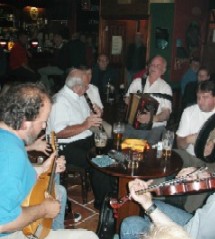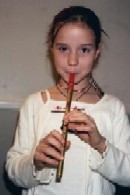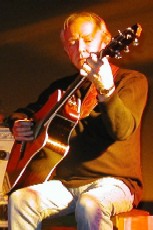![]() Music in Ireland
Music in Ireland
Music has a strong hold on Ireland, perhaps because a songline runs through the geography and the history of the country. It would be possible to drive any circuitous route you liked from the north of Donegal to the southernmost tip of Cork and, as you travelled, sing songs and play tunes that named and described every mile of the landscape passed. 'The Enniskillen Dragoons', 'The Hackler of Cootehall', 'The Kesh Jig', 'The Mountains of Mourne', 'The Fields of Athenry', 'The Limerick Rake', 'The Bantry Girls Lament.' Every parish, village, market town, hill and lake comes with its own song. The reward for this musical safari, is being in the right place at the right time to catch a 'mighty session.' I'm not talking about the Aran sweaters, guitars and 'Danny Boy' stuff, but the real sessions where musicians, fuelled by alcohol, thick smoke and the weather outside, lash into jigs and reels, lifting each other's playing to ever greater heights, and carrying anyone listening along with them. It's the uncertainty, the randomness of sessions that are their attraction. Nobody plans the best ones. Or knows exactly where one might start up. The right musicians meet, a few more people gather around in anticipation, there's drink and talk to pass the hours until the 'right' moment. Then instrument cases are pulled down from shelves and fished from under benches. A fiddle is taken out and tuned. An air started. A concertina is unboxed, then a bouzouki. More players join in. And suddenly the session's on. It's a kind of alchemy that may or may not produce gold - you put the ingredients together and see what happens.  Traditional musicians need an audience, but a knowledgeable audience, and they'll travel to find one. Here's a paradox. It costs good money to get some mediocre guitar tickler to sit in a faked-up Irish bar playing 'The Rose of Tralee' for guidebook-toting tourists. But the cream of Ireland's musicians, household names with CDs selling in five continents, will drive for hours to perch on rickety, vinyl-covered stools in some draughty, crossroads pub, AND they'll pay for their own drinks as well, just for the opportunity to trade tunes with their peers and play for people who know enough about music to know when it's really good.
Traditional musicians need an audience, but a knowledgeable audience, and they'll travel to find one. Here's a paradox. It costs good money to get some mediocre guitar tickler to sit in a faked-up Irish bar playing 'The Rose of Tralee' for guidebook-toting tourists. But the cream of Ireland's musicians, household names with CDs selling in five continents, will drive for hours to perch on rickety, vinyl-covered stools in some draughty, crossroads pub, AND they'll pay for their own drinks as well, just for the opportunity to trade tunes with their peers and play for people who know enough about music to know when it's really good.
Sessions: a session is any informal gathering of musicians playing together. Usually held in a pub, a session's defining characteristic is the blurred divide between audience and musicians. "Get up and give us a song", somebody supping a quiet pint at the back of the room will be encouraged, whilst musicians will randomly stop playing to talk with friends or roll cigarettes or the better to savour their drink. Nobody's being paid to play and the musicians are free to follow their muse as they will. Sessions produce the kind of music you can't buy. Though a session will often feature solo pieces and unaccompanied songs, the overall point is for musicians to play together, even if they're meeting for the first time. For this reason Irish traditional music is based on fixed music forms to give a firm foundation for the airy edifices built up from them.
Instruments: arguments over what constitutes a traditional Irish instrument have busied many a musician in defending his own chosen noise-maker. Early Irish music probably had little more than a simple harp, the Celtic horn, frame drum and basic whistle to draw on and the 'traditional instruments' of modern Irish music were all later imports. The need to play fast, ornamented melody to strict time in an ensemble setting has favoured certain instrumentation, leading to the predominance of fiddles, wooden flutes, uilleann pipes and the bodhran, the Irish drum.
 The acceptance of new instruments - and everything from saxophones to lutes have been tried over the decades - in Irish music has always depended on the skill and sensitivity of their players. For example, the odd jig or reel played on didgerido by the brilliant Australian guitarist Steve Cooney, is a pleasing novelty because he knows his way around the music, plays well and doesn't do it very often. But it's not something that's encouraged.
The acceptance of new instruments - and everything from saxophones to lutes have been tried over the decades - in Irish music has always depended on the skill and sensitivity of their players. For example, the odd jig or reel played on didgerido by the brilliant Australian guitarist Steve Cooney, is a pleasing novelty because he knows his way around the music, plays well and doesn't do it very often. But it's not something that's encouraged.
The Uilleann Pipe: a chanter bagpipe, blown by a bellows pumped under the arm. Often seen as the quintessential Irish instrument. Difficult to play well (or even acceptably), it's said to take seven years learning, seven years practicing and seven years playing to become a piper. Its 'bluesy' crying tone in slow airs, and keening yelps in fast pieces can lift a session high.
The Bodhran: a large tambourine shaped drum, usually played with a single, double headed 'beater.' The bodhran's apparent simplicity and the consequent enthusiastic flailings on it by non-musicians have led to its reputation as a session wrecker. "Ah, the Irish frisbee," declared one fiddler of my acquaintance, picking up a tourist's bodhran, and demonstrating his thesis by spinning it out of an open window.
 The Fiddle: "The fiddle is a violin played by a man who doesn't wear a bow-tie" I was told once. It has become the session instrument par excellence. Portable, capable of carrying the emotion of slow airs and the rush of passion in jigs and reels, playable quietly or loudly depending on ability and confidence, and blending well with other instruments. Fiddlers tend to be the keepers of the flame when it comes to the pure tradition.
The Fiddle: "The fiddle is a violin played by a man who doesn't wear a bow-tie" I was told once. It has become the session instrument par excellence. Portable, capable of carrying the emotion of slow airs and the rush of passion in jigs and reels, playable quietly or loudly depending on ability and confidence, and blending well with other instruments. Fiddlers tend to be the keepers of the flame when it comes to the pure tradition.
Whistles and Flutes: like the fiddle the wooden flute is another 'serious' instrument, as is the tin whistle if blown by a flute player. Equally, the tin or 'penny' whistle's cheapness tends to make it a bulk buy for tourists, along with tartan caps and shamrock tee-shirts, and so should never be pulled out at a session by anybody who can't really play the thing.
 'Boxes': the collective noun for accordions (which have keys like a piano) and concertinas (which have buttons). Accordions are too loud and inflexible to be good session instruments, though they can motor a ceili dance along, (which is why their players are referred to as 'drivers'). On the other hand the delicate and nimble sound of the concertina, and a more appropriate tuning, makes it a wonderful tool for sessions.
'Boxes': the collective noun for accordions (which have keys like a piano) and concertinas (which have buttons). Accordions are too loud and inflexible to be good session instruments, though they can motor a ceili dance along, (which is why their players are referred to as 'drivers'). On the other hand the delicate and nimble sound of the concertina, and a more appropriate tuning, makes it a wonderful tool for sessions.
Guitars, Bouzoukis, Mandolins and Banjos: the ability of fretted instruments to play chords and drive a piece along rhythmically has done a lot to change the range of sound in Irish music over the past 30 years. Guitars fuelled the ballad sessions made popular in the 1960s and 1970s by groups like the Clancy's and Dubliners, but they only made it as proper traditional instruments when reconfigured by players such as Arty McGlyn [see photo] and Paul Brady. Banjos and mandolins were in more suitable for 'carrying a tune' than guitars and fitted into the tradition better. Perhaps the strangest admission of a 'foreign' instrument into the inner circle of 'acceptables' (and this mainly to do with the skills of Andy Irvine and Donal Lunny) was the elevation of the flat-backed bouzouki into a genuinely innovative Irish instrument, in many ways filling a gap which the harp might have occupied in former times.
![]()